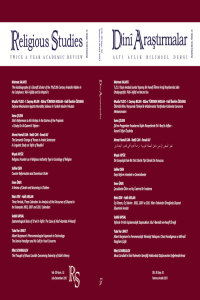THREE PERIODS, THREE CALENDARS: AN ANALYSIS OF THE DISCOURSES OF DIYANET IN THE EXAMPLES 2002, 2007 AND 2011 CALENDARS
Abstract
Calendars,
as old as humanity itself, emerged out of the attempt to break down time in
units and give meaning to life and time. As far as Islam is concerned, calendar
as a subject gain more importance because identifying daily and yearly rituals
and performing the rituals related to time on their specific time is an
essential part of Islamic religious life. With a circulation of three million
yearly and more than ten million readers, the calendar printed by the
Presidency for Religious Affairs of Turkey is a significant instrument in
forming, changing and maintaining religious perceptions. We were led to do such
a study by the lack of academic studies regarding this aspect of the calendars.
The study is based on the texts placed on the frontal and back sides of the
calendars printed and distributed by the Presidency for Religious Affairs in
the years of 2002, 2007 and 2011. The texts have been analysed by the textual
analysis method and the changes in religious perceptions have been pointed out.
Unlike the expected institutional continuity, when the three periods compared,
it is observed that considerable perception changes have taken place; many
subjects have been left out while many have been introduced into the calendars. The study
found out that as the years progressed and the periods passed, the calendars
also changed dramatically. The most apparent change occurred in the calendars
was global understanding in choosing or replacing the subjects. This means that
the 2007 and 2011 calendars have excluded some national and spiritual values
that were thought to be outmoded globally but included in the 2002 calendar.
This also signifies a breaking point in religious perceptions of the Presidency
for Religious Affairs.
References
- • Akgör, Necati, (2010) “Takvim”, Diyanet İslam Ansiklopedisi, Cilt 39, Ankara: Diyanet Vakfı Yayınları, s. 487-490. • DİB, (2002) Diyanet Blok Takvimi, Ankara: Diyanet İşleri Başkanlığı. • DİB, (2007) Diyanet Blok Takvimi, Ankara: Diyanet İşleri Başkanlığı. • DİB, (2011) Diyanet Blok Takvimi, Ankara: Diyanet İşleri Başkanlığı. • DİB, (2015) Diyanet Blok Takvimi, Ankara: Diyanet İşleri Başkanlığı. • Eagleton, Terry, (2004), Edebiyat Kuramı, İstanbul: Ayrıntı Yayınları. • Özel, İsmet, (1987), Erbain, İstanbul: İklim Yayınları. • Şulul, Kasım, (2002), “Hicri Takvimin Ortaya Çıkışı”, Harran Üniversitesi İlahiyat Fakültesi Dergisi, c. 4: s. 145-166. • Ulaş, Sarp Erk, (2002), Felsefe Sözlüğü, Ankara: Bilim ve Sanat Yayınları. • Unat, Yavuz, (2004) “Türklerde ve Müslümanlarda Zaman ve Takvim”, Türk Dünyası Nevruz Ansiklopedisi, Editör: Öcal Oğuz, Ankara: Atatürk Kültür Merkezi Başkanlığı Yayınları. • Yenen, İbrahim ve Adem Sağır, (2013), “Yaygın Eğitsel Bir Metin Olarak Takvim: 2012 Yılı Diyanet Takvimi Örneği”, Yaygın Din Eğitimi Sempozyumu- II, Ankara: Diyanet İşleri Başkanlığı Yayınları. • Yıldırım, Ali ve Hasan Şimşek, (2013), Sosyal Bilimlerde Nitel Araştırma Yöntemleri, Ankara: Seçkin Yayınları.
Abstract
Diyanet İşleri Başkanlığı tarafından basılan takvim, yıllık 3 milyonu aşan tirajı ve 10 milyondan daha fazla okuyucusu ile dikkate değer bir din algısı oluşturma, değiştirme ve devam ettirme aracıdır. Takvimlerin bu yönünün akademik açıdan fazla incelenmemiş olmaması, bizi bu çalışmayı yapmaya yöneltmiştir. Araştırmada, 2002, 2007 ve 2011 yılı Diyanet İşleri Başkanlığı
takvimlerindeki metinler, metin analizi yöntemiyle incelenmiştir. Dönemler bazında takvimlerde yer verilen konular kıyaslanmış, daha önceki dönemlerde takvimlerde yer verilen konuların son dönemde ilgi dışında bırakıldığı, pek çok yeni konunun ise son dönemde takvimlere dahil edildiği görülmüştür. Bu sonuçlar, kurumsal devamlılıktan beklenenin aksine üç dönem arasında ciddi bir algı değişimi olduğunu göstermektedir.
Keywords
References
- • Akgör, Necati, (2010) “Takvim”, Diyanet İslam Ansiklopedisi, Cilt 39, Ankara: Diyanet Vakfı Yayınları, s. 487-490. • DİB, (2002) Diyanet Blok Takvimi, Ankara: Diyanet İşleri Başkanlığı. • DİB, (2007) Diyanet Blok Takvimi, Ankara: Diyanet İşleri Başkanlığı. • DİB, (2011) Diyanet Blok Takvimi, Ankara: Diyanet İşleri Başkanlığı. • DİB, (2015) Diyanet Blok Takvimi, Ankara: Diyanet İşleri Başkanlığı. • Eagleton, Terry, (2004), Edebiyat Kuramı, İstanbul: Ayrıntı Yayınları. • Özel, İsmet, (1987), Erbain, İstanbul: İklim Yayınları. • Şulul, Kasım, (2002), “Hicri Takvimin Ortaya Çıkışı”, Harran Üniversitesi İlahiyat Fakültesi Dergisi, c. 4: s. 145-166. • Ulaş, Sarp Erk, (2002), Felsefe Sözlüğü, Ankara: Bilim ve Sanat Yayınları. • Unat, Yavuz, (2004) “Türklerde ve Müslümanlarda Zaman ve Takvim”, Türk Dünyası Nevruz Ansiklopedisi, Editör: Öcal Oğuz, Ankara: Atatürk Kültür Merkezi Başkanlığı Yayınları. • Yenen, İbrahim ve Adem Sağır, (2013), “Yaygın Eğitsel Bir Metin Olarak Takvim: 2012 Yılı Diyanet Takvimi Örneği”, Yaygın Din Eğitimi Sempozyumu- II, Ankara: Diyanet İşleri Başkanlığı Yayınları. • Yıldırım, Ali ve Hasan Şimşek, (2013), Sosyal Bilimlerde Nitel Araştırma Yöntemleri, Ankara: Seçkin Yayınları.
Details
| Primary Language | Turkish |
|---|---|
| Journal Section | Articles |
| Authors | |
| Publication Date | December 15, 2017 |
| Published in Issue | Year 2017 Volume: 20 Issue: 52 (15-12-2017) |


